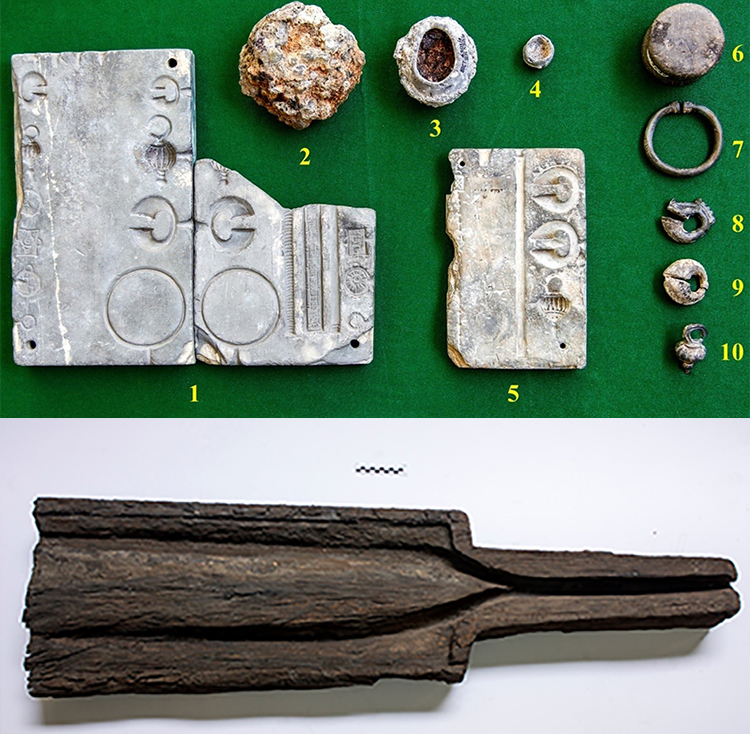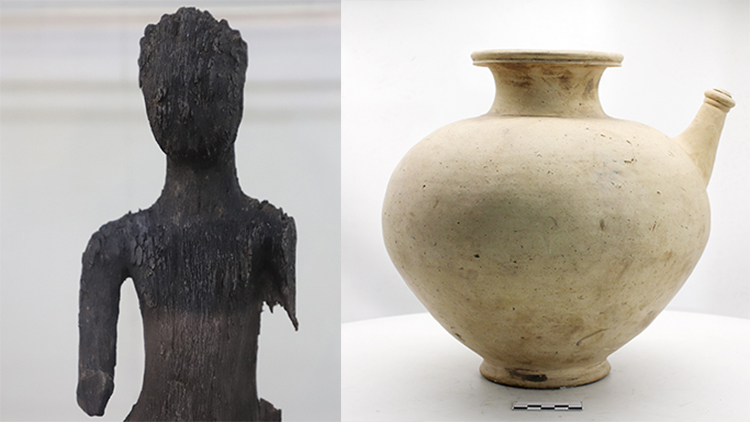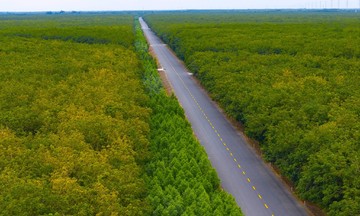Located on Highway 61C, 17 km from Can Tho city center, the 56-hectare Nhon Thanh Oc Eo relic site in Nhon Nghia commune reveals a vibrant river-dwelling community that thrived from the 4th to the 7th centuries. Archaeological findings depict a bustling scene of boats and stilt houses along canals, characteristic of the Oc Eo culture.
 |
Two national treasures: a set of casting molds (1st-7th centuries) and a wooden Linga-Yoni (5th century) found at the Nhon Thanh relic site. Photo: An Binh |
Two national treasures: a set of casting molds (1st-7th centuries) and a wooden Linga-Yoni (5th century) found at the Nhon Thanh relic site. Photo: An Binh
Since 1990, the Can Tho Museum, in collaboration with various organizations, has conducted numerous surveys and excavations at the site. Thousands of artifacts have been unearthed, notably the remnants of a jewelry workshop containing casting molds, metal smelting pots, rings, earrings, amulets, and beads made of gold, alloys, precious stones, and glass.
In addition, over 16,000 pottery fragments, household items like jars and stoves, and artifacts crafted from bone and ivory have been discovered. Archaeologists also documented evidence of woodworking, wood carving, stilt house pillars, fireplaces, and animal bones, illustrating the dynamic life of the ancient inhabitants.
At Lung Cot Cau Lake within the relic site, experts discovered a well-preserved 4-meter-long wooden staircase and a 5.4-meter-long dugout canoe, identified as the oldest and most intact Oc Eo culture boat found in the Mekong Delta.
 |
A Buddha statue (4th-6th centuries) and a ceramic jar (5th century) from the Nhon Thanh relic site, recognized as national treasures. Photo: An Binh |
A Buddha statue (4th-6th centuries) and a ceramic jar (5th century) from the Nhon Thanh relic site, recognized as national treasures. Photo: An Binh
Remarkably, four national treasures have been unearthed at the Nhon Thanh site.
The first is a set of casting molds (1st-7th centuries), demonstrating the advanced jewelry-making skills and the complete jewelry production process of the Funan people. Recognized in late 2017, it was Can Tho city's first national treasure.
The second is the Nhon Thanh ceramic jar (5th century), made from fine clay. It is considered a masterpiece of ceramic craftsmanship, reflecting the cultural exchange between India and the indigenous population. It was recognized as a national treasure in 2018.
The third is the Nhon Thanh wooden Buddha statue (4th-6th centuries), carved in the tribhanga posture on a two-tiered lotus pedestal, with elegant lines and traces of gold leaf. This unique artifact represents Buddhist art in wood within the Oc Eo culture and was recognized in late 2018.
The fourth is the wooden Linga-Yoni (5th century), the only wooden artifact of its kind found in southern Vietnam and Southeast Asia, symbolizing fertility beliefs. It was recognized as a national treasure in early 2020.
These four national treasures are currently on display at the Can Tho City Museum.
 |
Lung Cot Cau Lake within the Nhon Thanh relic site. Photo: Hoang Viet |
Lung Cot Cau Lake within the Nhon Thanh relic site. Photo: Hoang Viet
According to Associate Professor Dr. Bui Chi Hoang, former deputy director of the Institute of Social Sciences in the Southern Region, Nhon Thanh holds exceptional value for researching the history of the Mekong Delta's development. It reflects the settlement, establishment, and growth of the first inhabitants, marking one of the region's most prosperous eras.
The relic site area has become a hub for fruit tree cultivation and ecotourism. Can Tho's Department of Culture is preparing a dossier to nominate Nhon Thanh as a special national relic site, while also developing preservation and promotion plans in accordance with the 2024 Cultural Heritage Law.
An Binh












